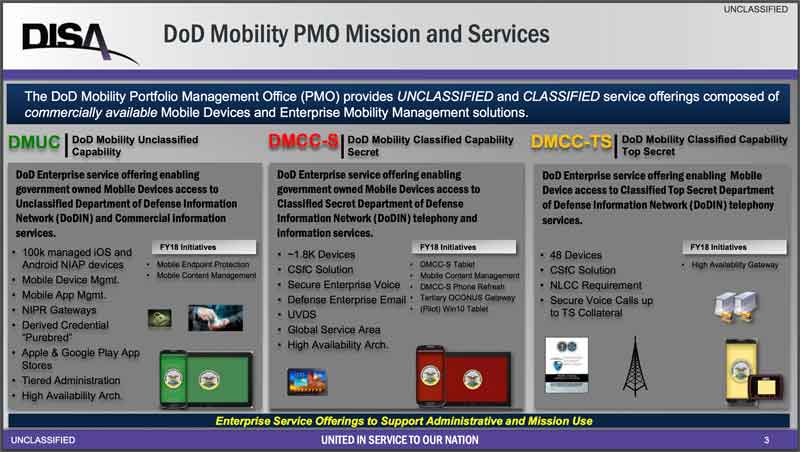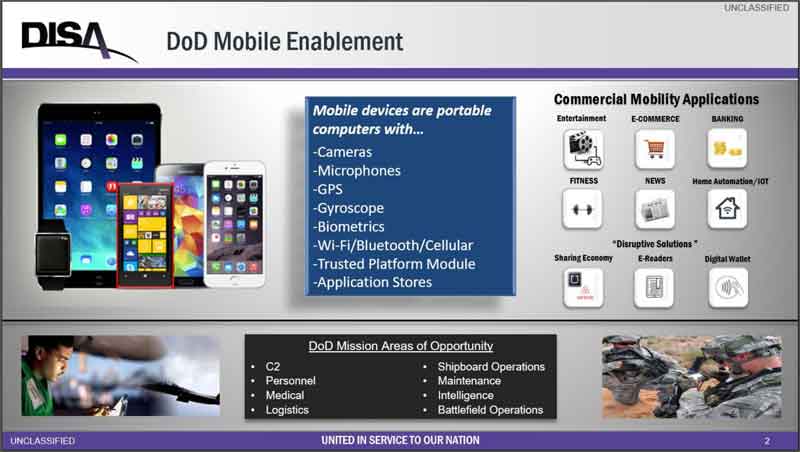
More than 100,000 service members and civilians are using unclassified mobility solutions provided by the Defense Information Systems Agency (DISA), and that number is growing steadily, said Jake Marcellus, manager of the Department of Defense (DOD) Mobility Program, during the 2018 Armed Forces Communications and Electronics Association’s Defensive Cyber Operations Symposium in Baltimore May 17.
The program has approximately 1,600 classified mobility customers.
Both service offerings are accessed via commercially available mobile devices, said Marcellus, who was joined by a panel of experts that provided updates on evolving capabilities in the DOD Mobility Program portfolio.
“We are responsive to the needs of mission partners,” said Marcellus.
“When our customers are interested in capabilities, we want our team to explore them.”
(Learn More. Jake Marcellus, portfolio manager for the DOD Mobility Portfolio Management Office, provides an overview of DOD mobility and its initiatives, why mobility is important, and how mobility enables our warfighters and mission partners to be effective anytime, anywhere. Courtesy of USDISA and YouTube. Posted on Jan 24, 2018)
Improving the mobile app review and approval process
Mission partners have expressed concern about the lengthy process to vet, analyze, and map mobile applications before they are made available to users in the DOD Mobile Application Store.
Mobile applications are reviewed via the DOD Mobility Unclassified Capability (DMUC) mobility application vetting process, which tests, validates, and verifies mobile applications against DOD security requirements.
Neil Mazuranic, chief of the DOD Mobility Program Mobility Capabilities Branch, worked with application leads and integration engineers to review the vetting process and identify areas for improvement.
As a result, the program established a method to review and score mobile applications and is currently working with authorizing officials to create a set of requirements to approve applications immediately.
“Now we’re at a point where as the applications come in, we can turn around – in the same month – vet them, get them approved, and get them out,” said Mazuranic.
“Three, four, or five weeks might seem a bit excessive, but it’s better than the 12-18 months we were predicting a year and a half ago.”
(Learn More from Neil Mazuranic at the Federal Innovation Summit. Courtesy of FedScoop and YouTube. Posted on Mar 27, 2018)
Improved security for classified mobility
Frank Cabral Jr., deputy portfolio manager of the DOD Mobility Program, highlighted recent program milestones to improve security for mobility customers around the world.
The team completed phase 1 of the DOD mobile endpoint protection prototype, applying protection at mobile endpoints in accordance with DOD regulations.
They reviewed 25 proposed commercial solutions and selected two vendors to conduct testing during phase 2 of the prototype.

The third planned DOD Mobility Classified Capability gateway will be completed by the end of the calendar year.
This gateway will be located outside the continental U.S., said Cabral.
Expanding availability of classified tablets
Cabral also spoke about two new tablet solutions for the classified mobile platform.
A DOD Mobility Classified Capability-Secret (DMCC-S)-compatible non-data-at-rest Android tablet is available now via DISA Storefront.
The tablet provides a number of features, including secure voice via the Defense Red Switch Network (DRSN) and Defense Enterprise Email (DEE).
















